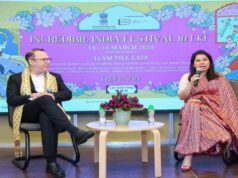Originally published in Hebrew in 2011, the English translation of Sapiens came out in 2014 and was translated into 45 languages by June 2017. Bill Gates ranks it among his favourite books. The Guardian listed it among the ‘10 best brainy books of the decade’. Among other fans of the book are Barack Obama, Mark Zuckerberg and Chris Evans.

Yuval Noah Harari, a PhD in History from Oxford University, teaches at the Hebrew University of Jerusalem. He specialized in medieval and military history.
He is hugely inspired by Jared Diamond’s ‘Guns, Germs & Steel’ published in 1997 and similar to that book understood that it was possible to “ask very big questions and answer them scientifically”. He sets out to do just that, with wit and humor, simplifying complex topics and concepts. And while doing so he gathers a large fan base. People who are able to understand and appreciate that he does not disdain or disparage the ordinary man.

This book endeavours to provide a concise summary of the march of human evolution – in under 500 pages. Here is what I learned from this book –
A hundred thousand years ago, there were six species on the planet, now there is only one – us, Homo Sapiens. Fire gave us power. Farming made us hungry for more. Money gave us purpose and science made us deadly! While we survived and thrived, the world around us paid a high price which manifested itself in the extinction of a number species. We are where we are today because of the three revolutions – Cognitive revolution which took place 70,000 years ago, Agricultural revolution 12,000 years ago and finally the Scientific revolution which is as recent as 500 years ago and which allowed us to change our environment in permanent ways. Scientific advancements such as AI and robotics allow humans to play God. Where will we draw the line?
I found this line especially fascinating – ‘Biology enables, Culture forbids’. In my opinion, using a cross-disciplinary approach to explain theories in the book allows the author to switch between history, sociology, anthropology and biology and a layman to get a broad overview of the concepts.
While the topic is heavy, the language throughout is engaging and the tone easy and conversational. Harari does not overwhelm his readers with jargon, nor does he get too obscure with theories that he addresses in this book. ‘How do you cause people to believe in an imagined order such as Christianity, democracy or capitalism? First, you never admit that the order is imagined’.
I found the attitude of the author refreshing – he doesn’t talk down to his readers, nor does he lecture them or condescends… it makes reading a pleasure. Harari presents complex facts in simple terms. It is hard to explain something long and complicated in a way everyone can enjoy. Harari accomplishes that effectively.
Despite being well-received by the public (it made may best seller lists in the non-fiction genre), it got quite an unkind reception from the scholars with many calling it ‘infotainment at best’ with ‘unsourced assertions’. Many academicians wrote lengthy reviews lambasting Harari’s theories word by word. They took offense with his calling the agricultural revolution ‘a fraud’. Harari went on to say that ‘History is something that very few people have been doing while everyone else was ploughing fields and carrying water buckets’.
None of this has affected the popularity of the book which garners more fans and more reviews with each passing day.
On the last page of the book I found this line:
We are more powerful than ever before…Worse still, humans seem to be more irresponsible than ever. Self-made gods with only the laws of physics to keep us company, we are accountable to no one. (p466)
With a statement such as this, Harari is asking for a volatile reaction. But then I thought this is exactly the kind of statement that sells books because it gets people talking while the pseudo-intellectuals argue themselves hoarse.
The author is an intense writer and he is excellent in certain topics – notably the fields he specializes in. However, in trying to encompass too wide a field with generalizations he spreads himself too thin and loses the gravitas required for a topic such as this. While the general populace is going gaga, the academicians are up in arms refuting Harari’s theories and claims. Featuring 27 photographs, 6 maps and 25 illustrations/diagrams, this provocative and insightful work is sure to trigger heated arguments and discussions.





